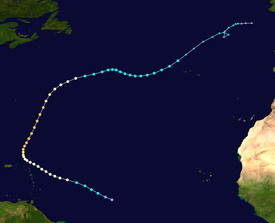Hurricane Erika (1997)
The passage of Erika carried a cloud of volcanic ash to Antigua from the eruption of the Soufrière Hills Volcano on Montserrat, a rare occurrence.
Strong waves from the hurricane produced beach erosion and coastal flooding in northern Puerto Rico, and caused the death of two surfers.
[2] A large system, the depression possessed persistent convective banding as early as its formation, though these features were initially well away from cyclone's center.
[3] The depression moved west-northwestward at approximately 20 mph (32 km/h) under the influence of a well-established subtropical ridge, and late on September 3, the system intensified into a tropical storm.
[4] Erika continued to the west-northwest, and in the early hours of September 4, an eye-like feature appeared to have developed in the center of the deep convection.
Despite unfavorable wind shear, Erika strengthened further and intensified into a hurricane at 18:00 UTC on September 4, while located 530 miles (850 km) east-southeast of Guadeloupe.
[2] Just three hours earlier, the NHC predicted that Erika would remained a tropical storm through September 7, as wind shear was not projected to become more favorable in the next day or so.
[5] Operationally, the NHC did not upgrade Erika to a hurricane until 15:00 UTC on September 5, upon receiving reports of reconnaissance missions observing flight-level sustained winds of 86 to 92 mph (138 to 148 km/h) in several areas of the cyclone.
[2] After passing about 350 miles (560 km) east of Bermuda on September 10, Erika turned to the east-northeast in response to westerly steering currents.
Erika continued to weaken as it turned to the east-southeast, though it maintained deep convection near the center despite unfavorable atmospheric conditions.
On September 14 the storm turned to the northeast again, and re-strengthened to reach winds of 70 mph (110 km/h) while located 510 miles (820 km) west-southwest of the Azores.
[7] The governments of the islands in the predicted path of Erika urged residents to quickly prepare for the hurricane through radio addresses.
Just weeks after the eruption of the Soufrière Hills Volcano on Montserrat, the storm blew a cloud of falling ash over Antigua.
The hurricane produced swells of 10 to 12 ft (3.0 to 3.7 m) on the northern coast of Puerto Rico, causing beach erosion or coastal flooding.
The lowest recorded pressure by a ship was 1000.4 mbar (29.542 inHg) while located 105 miles (169 km) from Erika as an extratropical storm.

Tropical storm (39–73 mph, 63–118 km/h)
Category 1 (74–95 mph, 119–153 km/h)
Category 2 (96–110 mph, 154–177 km/h)
Category 3 (111–129 mph, 178–208 km/h)
Category 4 (130–156 mph, 209–251 km/h)
Category 5 (≥157 mph, ≥252 km/h)
Unknown
